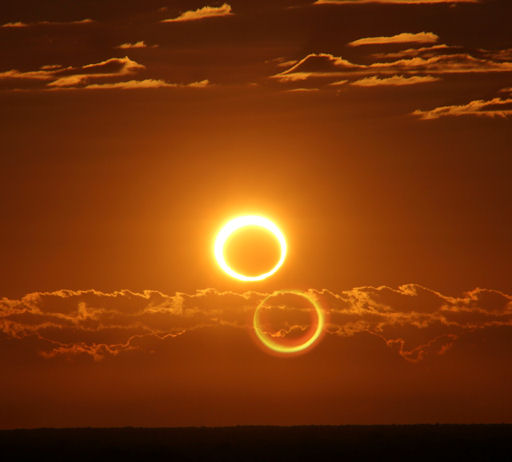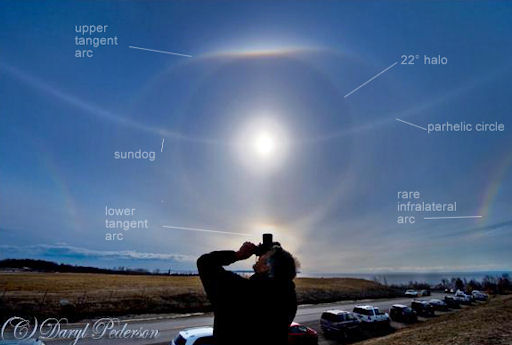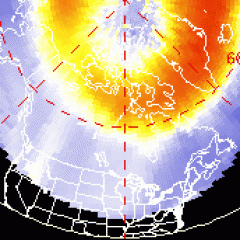M-CLASS SOLAR FLARE: A sunspot located just behind the sun's northeastern limb erupted during the early hours of May 10th, producing an M3-class solar flare. NASA's Solar Dynamics Observatory recorded the explosion's extreme ultraviolet flash: movie. The farside active region will turn toward Earth in the days ahead, so stay tuned. Solar flare alerts: text, voice.
"RING OF FIRE" SOLAR ECLIPSE: As the sun rose over Australia on Friday morning, May 10th, the solar disk turned into a ring of fire. The day began with an annular solar eclipse:
Nicole Hollenbeck took the picture from inside the narrow path of annularity about 70km south of Newman, Australia. At the time, more than 95% of the sun's diameter was covered by the Moon.
In an annular eclipse the Moon is not quite big enough to cover the entire solar disk. A blinding ring of solar fire juts out around the Moon, overwhelming the sun's delicate corona. It may not be the same as totality, but annularity has a charm and beauty all its own. Browse the gallery for more images from the eclipse zone.
Realtime Solar Eclipse Photo Gallery
SPECTACULAR PROMINENCE, GONE: For the past few days, astronomers around the world have been monitoring a bushy filament of magnetism dancing along the sun's western limb. Sergio Castillo of Inglewood CA photographed the structure on May 9th just before it collapsed:
"OMG! This giant prominence was one of the most spectacular I have ever witnessed," says Castillo. "Yesterday, however, it collapsed on its own magnetic field and nothing remains of it."
The filament has disappeared from the sun, but all 250,000 km of it may still be found in the space weather photo gallery. Start looking.
Realtime Space Weather Photo Gallery
ICE HALO AROUND THE SUN: On May 6th, Daryl Pederson went to Point Woronzof in Anchorage, Alaska, to see the USS Anchorage depart. "But," says Pederson, "the sun refused to be outshone." Instead of photographing the amphibious warship, he recorded this complex ice halo in the sky overhead:
The luminous arcs and rings around the sun are caused by sunlight shining through ice crystals in thin, high clouds. Usually only one or two of these ice halos appears at once, but Pederson caught at least 6 different varieties, identified and labeled above by atmospheric optics expert Les Cowley.
"It is sometimes hard to believe that tiny ice crystals floating in the air or clouds can make such precise and beautiful sky geometry," comments Cowley. "Two reasons:- One, the small crystals unlike their larger and more familiar snowflake cousins are near optically perfect. Two, they are set firmly in near perfect alignments by aerodynamic drag forces as they drift slowly down relative to local air currents. Only the circular 22o halo comes from tumbling crystals and they generate geometric perfection, too!"

![]()
Solar wind
speed: 420.0 km/sec
density: 1.2 protons/cm3
explanation | more data
Updated: Today at 2056 UT
![]()
X-ray Solar Flares
6-hr max: C2 1643 UT May10
24-hr: M3 0057 UT May10
explanation | more data
Updated: Today at: 2100 UT
![]()
![]()
![]()
Daily Sun: 10 May 13
![]()
![]()
Sunspot AR1736 has a beta-gamma magnetic field that harbors energy for M-class solar flares. Credit: SDO/HMI
![]()
![]()
![]()
Sunspot number: 154
What is the sunspot number?
Updated 10 May 2013
Spotless Days
Current Stretch: 0 days
2013 total: 0 days (0%)
2012 total: 0 days (0%)
2011 total: 2 days (<1%)
2010 total: 51 days (14%)
2009 total: 260 days (71%)
Since 2004: 821 days
Typical Solar Min: 486 days
Update 10 May 2013
The Radio Sun
10.7 cm flux: 128 sfu
explanation | more data
Updated 10 May 2013
![]()
![]()
![]()
Current Auroral Oval:
![]()
Switch to: Europe, USA, New Zealand, Antarctica
Credit: NOAA/POES
![]()
![]()
![]()
Planetary K-index
Now: Kp= 1 quiet
24-hr max: Kp= 2 quiet
explanation | more data
![]()
Interplanetary Mag. Field
Btotal: 3.4 nT
Bz: 0.7 nT south
explanation | more data
Updated: Today at 2057 UT
![]()
![]()
![]()
Coronal Holes: 10 May 13
![]()
![]()
Solar wind flowing from this coronal hole should reach Earth on May 14-15. Credit: SDO/AIA.







